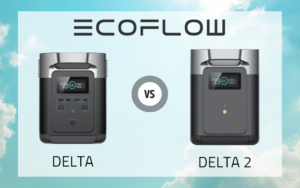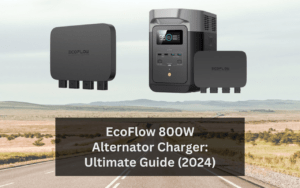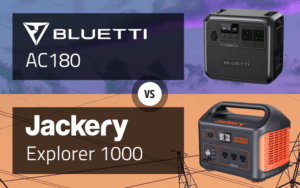Welcome to our comparison of EcoFlow DELTA 2 vs DELTA Max. This article will analyze the specifications and features of each model to help you make the best choice for your portable power needs. Both models look very similar but have some distinct differences, so we aim to use this article to highlight the differences that might sway your decision.
Both models are available as standalone portable power stations and can be integrated into broader solar generator systems, which include the core power station complemented by a selection of compatible solar panels. At the time of writing, they can both be purchased directly from the EcoFlow website as well as from the official EcoFlow Amazon store.
Note: the DELTA Max is available as both the DELTA Max (1600) and DELTA Max (2000) models, which differ in terms of their output and capacity – the (1600) model has 2,000W output and 1,612Wh capacity, whilst the (2000) model is slightly superior with 2,400W output and 2,016Wh capacity.
In addition to their solar panel and smart devices range, EcoFlow’s portable power station product line-up is categorised into two main series: the DELTA Series and the RIVER Series. The DELTA series is designed for those requiring robust power solutions, featuring models with higher capacities and outputs. On the other hand, the RIVER series caters to customers looking for more affordable options with moderate power needs.
EcoFlow’s DELTA range consists of the DELTA, DELTA Mini (now discontinued), DELTA Max, DELTA Pro, DELTA 2, DELTA 2 Max, DELTA Pro Ultra, and DELTA Pro 3 (where ‘Pro’ trumps ‘Max’). Click here to see the full range of DELTA products.
We always recommend purchasing EcoFlow products directly from their official website or Amazon store. While there are many reputable wholesalers and third-party sellers, buying from these sources may invalidate your warranty and make it more challenging to contact customer support. For this reason, any and all links in this article will take you straight to the brands’ website or official Amazon store.
For more information on each brand’s warranty policies, visit EcoFlow‘s Warranty Policy webpage.
EcoFlow DELTA 2
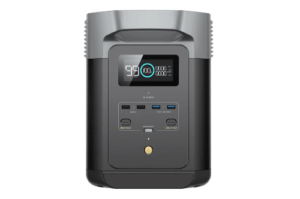
Price (UK): £899
Price (US): $999
Power (W): 1800
Capacity (Wh): 1024
Life cycles: 3000+ to 80%
Cell chemistry: LiFePO4
Weight: 27 lbs (12 kg)
Dimensions: 15.7 x 8.3 x 11 in
Warranty: 5 years
Customer rating: ⭐⭐⭐⭐⭐ (436)
Expandable capacity of up to 3kWh with ‘DELTA 2’, ‘DELTA 2 Max’, or ‘DELTA Max’ Smart Extra Batteries.
EcoFlow DELTA Max (1600)
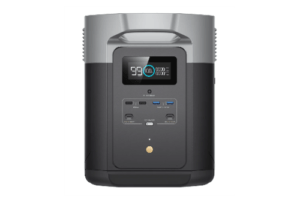
(Not currently available on Amazon)
Price (UK): £699
Price (US): $1,799
Power (W): 2000
Capacity (Wh): 1612
Life cycles: 500+ to 80%
Cell chemistry: NCM
Weight: 48 lbs (22 kg)
Dimensions: 19.6 x 9.5 x 12 in
Warranty: 2 years
Customer rating: ⭐⭐⭐⭐⭐ (290)
Expandable capacity of up to 6kWh with ‘DELTA Max’ Smart Extra Battery.
EcoFlow DELTA Max (2000)

Price (UK): £1,049
Price (US): $2,099
Power (W): 2400
Capacity (Wh): 2016
Life cycles: 800+ to 80%
Cell chemistry: NCM
Weight: 48 lbs (22 kg)
Dimensions: 19.6 x 9.5 x 12 in
Warranty: 2 years
Customer rating: ⭐⭐⭐⭐⭐ (290)
Expandable capacity of up to 6kWh with ‘DELTA Max’ Smart Extra Battery.
Comparison Overview Chart: EcoFlow DELTA 2 vs EcoFlow DELTA Max
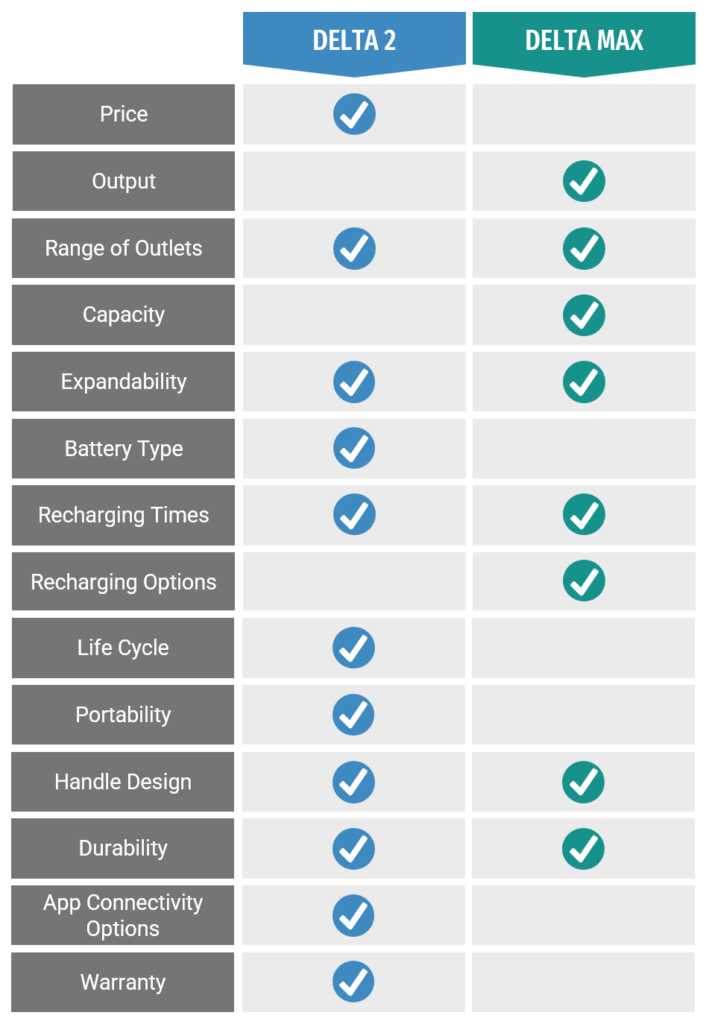
Price

At full price, the EcoFlow DELTA 2 is cheapest at $999, compared to the DELTA Max (1600) at $1,799 and the DELTA Max (2000) at $2,099. However, EcoFlow products are frequently on sale, so it’s worth checking the product pages before making a final decision.
Output (W)

In terms of base output, the EcoFlow DELTA Max (2000) leads with an output of 2400W, compared to the DELTA Max (1600) at 2000W, and the DELTA 2 at 1800W.
All models also have a surge capacity feature – both the DELTA Max (2000) and (1600) models have a massive surge capacity of 5000W, while the DELTA 2 has a surge capacity of 2700W.
Each model also has ‘X-boost’ technology to prevent overloading. When using this feature, the max device power is as follows:
- DELTA 2: 2200W (2400W in UK)
- DELTA Max (1600): 2800W
- DELTA Max (2000): 3400W
Outlet Options

The EcoFlow DELTA 2 and DELTA Max models have the exact same total number and type of charging ports – the only difference being the power output of the AC ports (as discussed above). Note that the number of ports may differ between regions – for example, in the US the DELTA 2 has 6x AC outlets, whereas in the UK it only has 4x.
Below is the full list of outlet options for each model (for the US):
DELTA 2:
- AC: 6x outlets, 1800W total (4x in the UK)
- USB-A: 2x ports, 5V, 2.4A, 12W Max
- USB-A Fast Charge: 2x ports, 5V, 2.4A / 9V, 2A / 12V, 1.5A, 18W Max
- USB-C: 2x ports, 5/9/12/15/20V, 5A, 100W Max
- Car: 1x port, 12.6V, 10A, 126W Max
- DC5521: 2x ports, 12.6V, 3A, 38W Max
DELTA Max (1600):
- AC: 6x outlets, 20A, 2000W total
- USB-A: 2x ports, 5V, 2.4A, 12W Max per port
- USB-A Fast Charge: 2x ports, 5V, 2.4A / 9V, 2A / 12V, 1.5A, 18W Max per port
- USB-C: 2x ports, 5/9/12/15/20V, 5A, 100W Max per port
- Car: 1x port, 12.6V, 10A, 126W Max
- DC5521: 2x ports, 12.6V, 3A, 38W Max per port
DELTA Max (2000):
- AC: 6x outlets, 2400W total
- USB-A: 2x ports, 5V, 2.4A, 12W Max per port
- USB-A Fast Charge: 2x ports, 5V, 2.4A / 9V, 2A / 12V, 1.5A, 18W Max per port
- USB-C: 2x ports, 5/9/12/15/20V, 5A, 100W Max per port
- Car: 1x port, 12.6V, 10A, 126W Max
- DC5521: 2x ports, 12.6V, 3A, 38W Max per port
None of the models have wireless charging ports.
Capacity (Wh)

The EcoFlow DELTA 2 has the lowest base capacity at 1,024Wh, while the EcoFlow DELTA Max (1600) has a 1,612Wh capacity, and the EcoFlow DELTA Max (2000) is higher still at 2,016Wh.
All three models offer expandable capacity – the DELTA 2 can be scaled up to 3kWh with the addition of the ‘DELTA 2’, ‘DELTA 2 Max’, or ‘DELTA Max’ Smart Extra Batteries. The DELTA Max (1600) and (2000) models are expandable up to 6kWh with the ‘DELTA Max’ Smart Extra Battery.
Battery

The EcoFlow DELTA 2 uses a LiFePO4 (lithium iron phosphate, also called LFP) battery, which has significant advantages in safety, durability, and efficiency. LiFePO4 batteries have the safest profile among lithium battery types, with a much lower risk of overheating or catching fire, even under stressful conditions.
The DELTA Max (1600) and DELTA Max (2000) both use NCM (Lithium Nickel Cobalt Manganese) batteries. NCM batteries are known for being lightweight and cost-effective, however, they have a shorter lifespan and can be more prone to overheating compared to other types, such as LiFePO4 batteries.
Despite their higher cost and heavier weight, we always tend towards recommending LiFePO4 batteries due to their superior safety profile and longer life cycle (which is around 4-5 times longer than that of NCM batteries). This can be seen from the models’ given life cycles: the DELTA 2 has 3000+ life cycles before dropping to 80% capacity, compared to the DELTA Max (1600)’s 500+ cycles and the DELTA Max (2000)’s 800+ cycles. This longer lifespan makes them more economical in the long run despite their higher initial cost and weight.
Recharging Options and Speed
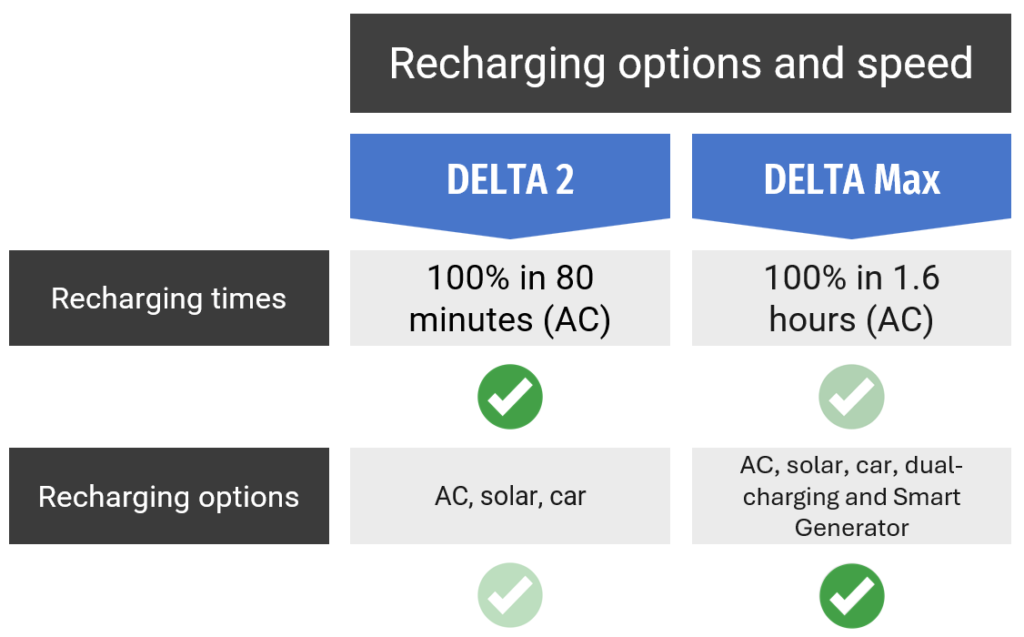
The EcoFlow DELTA 2 generally has faster charging speeds than the DELTA Max models, although the DELTA Max models offer additional dual charging and Smart Generator options. Both the DELTA 2 and the DELTA Max models support AC, solar, and car charging.
To break this down further, the DELTA 2 can be charged via AC to 80% in 50 minutes, or 100% in 80 minutes. This is faster compared to the DELTA Max which charges to 80% in 65 minutes, or 100% in 1.6-1.8 hours.
For charging via solar panels, the DELTA 2 can be fully charged in 3-6 hours with an optimal solar panel setup (1x 400W or 2x 220W panels) for a max input of 500W (11-60V, 15A). The DELTA Max takes 2.5-5 hours to charge via solar, depending on the setup, and is able to receive a max solar input of 800W (11-100V, 13A), e.g. with 2x 400W panels.
Both the DELTA 2 and the DELTA Max models can also be charged via car. This charging process takes a while, so it’s usually not very useful, however, both the DELTA 2 and DELTA Max can be paired with the EcoFlow 800W Alternator Charger to increase car charging times. For example, combining the DELTA 2 with the 800W Alternator Charger increases car charging times by 8x, charging 1kWh on a 1.3 hour drive.
You may be interested in reading: EcoFlow 800W Alternator Charger: Ultimate Guide (2024)
Dual charging and EcoFlow Smart Generator
The main difference between the EcoFlow DELTA 2 vs DELTA Max is that the DELTA Max (1600) and (2000) can combine AC with solar for even faster dual charging (up to 2600W). It can also be paired with the EcoFlow Smart Generator to further enhance recharging speed – using the EcoFlow Smart Generator alone, it accepts up to 2600W, but it can also be charged with AC + Smart Generator for up to 3400W input. This ability to combine with the EcoFlow Smart Generator is a feature specific to the DELTA Max, and is not possible with the DELTA 2.
Charge Life Cycles

As mentioned in the above Battery section, the DELTA 2 has 3000+ life cycles before dropping to 80% capacity, compared to the DELTA Max (1600)’s 500+ cycles and the DELTA Max (2000)’s 800+ cycles.
Rate and Depth of Discharge

The rate of discharge, or C rating, measures how quickly a battery can be discharged relative to its maximum capacity. A 1C rating means the battery can be discharged in one hour, delivering its full capacity. For example, a 1Ah battery at 1C provides 1A for one hour. At 0.5C, the same battery would provide 0.5A for two hours, and at 2C, it would deliver 2A for 30 minutes. Higher C rates can lead to reduced efficiency and faster depletion due to increased losses during rapid discharges.
For more reading on C-rates, we recommend this helpful resource from batteryuniversity.com.
Depth of Discharge (DoD) refers to the percentage of a battery’s capacity that has been used. A higher DoD indicates a greater amount of energy has been drawn from the battery. For instance, a battery with a DoD of 80% has used 80% of its capacity.
Even though the DELTA 2 uses LiFePO4 batteries while the DELTA Max uses NCM batteries, both are types of lithium battery, therefore they share very similar C rating and DoD – which makes life a little easier when it comes to comparing the models on this aspect.
The DELTA 2 uses a LiFePO4 battery, which supports a higher discharge rate and is known for its long cycle life, often reaching between 3000 to 6000 cycles. Like NCM batteries, the typical LiFePO4 battery has a C-rate of 1C. While LiFePO4 batteries can technically be discharged to 100% DoD, it is generally recommended to discharge them to only 80-90% to maintain optimal battery health and longevity. The DELTA Max (1600)’s NCM battery has a discharge rate of 1C and a depth of discharge (DoD) of 80-90%. This makes it suitable for moderate power needs, ensuring good battery health over its lifespan.
So, in terms of discharge rate and DoD, all three models’ batteries have very similar specs – 1C discharge rate and an 80-90% DoD. In any case, it’s not recommended to exceed a depth of discharge of 80% in order to preserve the battery’s health.
Portability
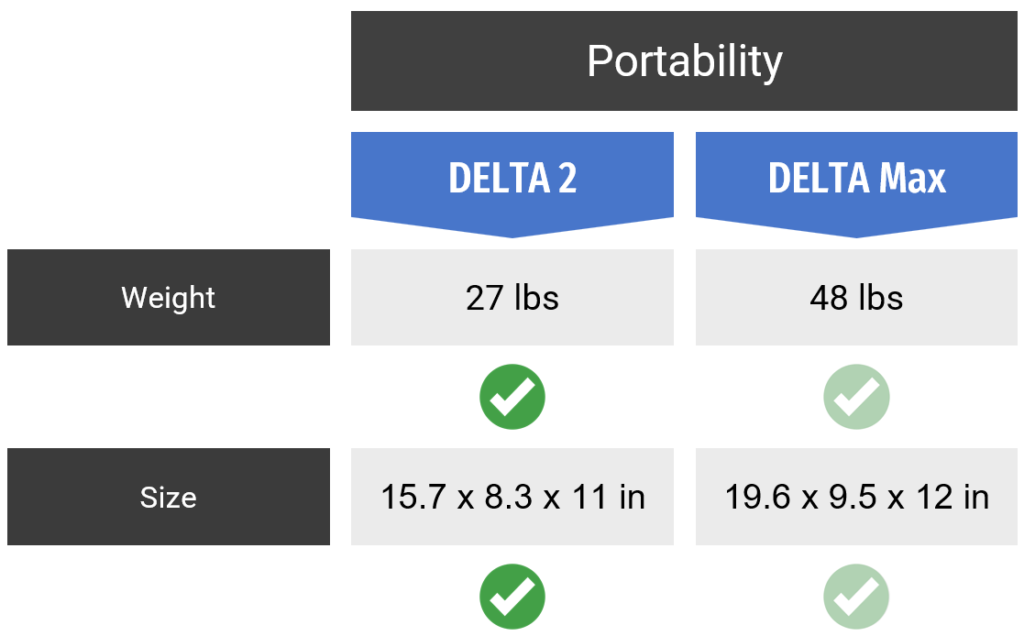
Weight
Weighing 27 lbs (12kg), the DELTA 2 is the lightest option. The DELTA Max (1600) and (2000) models are both significantly heavier at approximately 48 lbs (22 kg), making it less portable than the DELTA 2, and perhaps more suitable for stationary use.
Size
The DELTA 2 is also the smaller option, at 15.7 x 8.3 x 11 in (40 x 21.1 x 28.1 cm), compared to the DELTA Max at 19.6 x 9.5 x 12 in (49.7 x 24.2 x 30.5 cm). Despite the size differences, all three models are designed for portability, so it’s still very possible to use the DELTA Max (1600) and (2000) models on the go.
Handle design
The DELTA 2 and DELTA Max models have the same handle design – two handles on the front and back of the power station, which extend outwards (as shown in the image below).
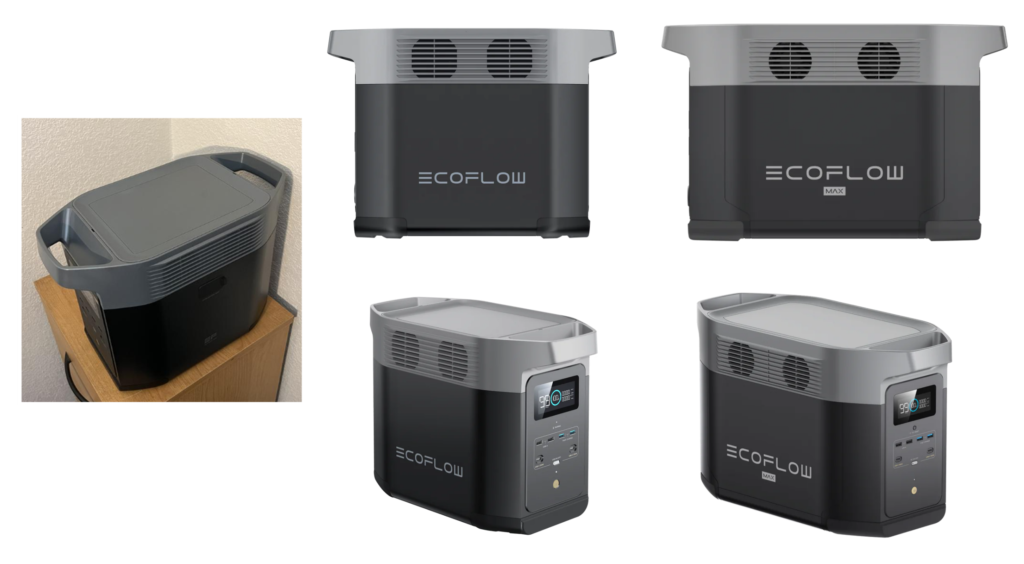
Durability

App Control and Connectivity

Both the EcoFlow DELTA 2 and DELTA Max models offer remote control and connectivity through their respective smartphone apps. However, while the DELTA 2 can connect using both Wi-Fi and Bluetooth, the DELTA Max is only able to connect with Wi-Fi.
The app provides options for remote control and real-time monitoring, including insights into battery status, power usage, and the option to control settings such as charging limits and port activation. Generally, reviews have positive sentiments towards these apps, which are described as being convenient and offering good functionality. The ability to interact with their power stations is particularly useful in outdoor or backup scenarios, although some users noted occasional connectivity issues which required a device restart or app refresh to resolve.
Warranty

The EcoFlow DELTA 2 has a longer warranty period of 5 years compared to the DELTA Max, which has a warranty period of 24 months (2 years). This is likely due to the DELTA 2’s LiFePO4 battery lending it a much longer life cycle than the DELTA Max.
Full Comparison Table
EcoFlow DELTA 2 vs DELTA Max specifications
| Feature | EcoFlow DELTA 2 | EcoFlow DELTA Max (1600) | EcoFlow DELTA Max (2000) |
| Price | $999 | $1,799 | $2,099 |
| AC Output (W) | 1800W | 2000W | 2400W |
| Surge Power (W) | 2700W | 5000W | 5000W |
| Battery Capacity (Wh) | 1024Wh | 1612Wh | 2016Wh |
| Expandable Capacity | Expandable up to 3kWh | Expandable up to 6kWh | Expandable up to 6kWh |
| Battery Type | LiFePO4 | NCM | NCM |
| Life Cycles | 3000+ cycles | 500+ cycles | 800+ cycles |
| AC Outlets | 6x outlets (4x in UK) | 6x outlets | 6x outlets |
| USB-A Outlets | 2x ports, 12W Max | 2x ports, 12W Max | 2x ports, 12W Max |
| USB-C Outlets | 2x ports, 100W Max | 2x ports, 100W Max | 2x ports, 100W Max |
| DC5521 Outlets | 2x ports, 38W Max | 2x ports, 38W Max | 2x ports, 38W Max |
| Car Outlets | 1x port, 126W Max | 1x port, 126W Max | 1x port, 126W Max |
| Wireless Charging Pad | No | No | No |
| Solar Charging | Max 500W (3-6 hours) | Max 800W (2.5-5 hours) | Max 800W (2.5-5 hours) |
| AC Charging | 80% in 50 mins, 100% in 80 mins | 80% in 65 mins, 100% in 1.6-1.8 hours | 80% in 65 mins, 100% in 1.6-1.8 hours |
| Car Charging | Supports car charging and 800W Alternator Charger | Supports car charging | Supports car charging |
| Weight (lbs) | 27 lbs | 48 lbs | 48 lbs |
| Dimensions (in) | 15.7 x 8.3 x 11 in | 19.6 x 9.5 x 12 in | 19.6 x 9.5 x 12 in |
| Smart App Control | Wi-Fi and Bluetooth | Wi-Fi | Wi-Fi |
| Warranty | 5 years | 2 years | 2 years |
Full comparison table for EcoFlow DELTA 2 vs EcoFlow DELTA Max.
Customer Reviews
Both the DELTA 2 and DELTA Max models have customer reviews averaging 4.9/5, which is the case for almost all of EcoFlow’s products. Below, we have compiled the most frequent or significant customer feedback for you to review.
DELTA 2: ⭐⭐⭐⭐⭐ (436)
- ✅ High capacity and fast charging: Customers are impressed with the DELTA 2’s substantial battery capacity and its ability to charge quickly, often reaching 80% in just 50 minutes via AC, making it ideal for both emergency and recreational use.
- ✅ Portability and build quality: Many users highlight the DELTA 2’s lightweight, compact design and robust build, which makes it easy to transport and durable enough for outdoor activities.
- ✅ Advanced battery technology: The LiFePO4 battery technology is favoured by many for its longevity and safety, providing peace of mind with a longer lifespan and more reliable performance compared to traditional lithium-ion batteries.
- ✅ App functionality: The EcoFlow app receives positive feedback for its user-friendly interface and remote control capabilities, allowing users to monitor and manage their power station conveniently from their smartphones.
- ❌ App connectivity issues: Some users reported occasional difficulties with the app reconnecting to the power station, requiring physical intervention to reset the connection.
- ❌ Fan noise: A few reviewers noted that the cooling fan can be quite loud, especially when the unit is under heavy load or charging at high speeds.
- ❌ Auto timeout feature: There were mentions of the auto timeout feature being triggered even when powering low-current devices, which some found inconvenient.
- ❌ Inconvenient handle placement: Some users noted that the placement of the handles at the ends of the DELTA 2’s length is inconvenient, as they stick out, making it harder to store the DELTA 2 in compact spaces.
DELTA Max: ⭐⭐⭐⭐⭐ (290)
- ✅ High capacity and versatility: Customers appreciate the DELTA Max’s substantial battery capacity and its ability to power a wide range of devices, including home appliances, tools, and recreational equipment. It’s particularly useful for backup power during outages and for off-grid activities.
- ✅ Fast charging and multiple charging options: The DELTA Max can be charged quickly via AC, solar panels, or even a car outlet, providing flexibility in different scenarios. Users are impressed with the fast charging speeds and the ability to monitor the charging status via the EcoFlow app.
- ✅ Portability and build quality: Despite its large capacity, the DELTA Max is praised for being relatively portable and well-built. The handles make it easier to carry, and the robust construction ensures durability for various uses.
- ✅ Quiet operation: Compared to traditional gas generators, the DELTA Max operates quietly, making it suitable for use in residential areas and during nighttime.
- ❌ App connectivity issues: Some users reported occasional difficulties with the app updating or reconnecting to the power station, requiring manual intervention to refresh the connection.
- ❌ Fan noise: While quieter than gas generators, the DELTA Max’s cooling fan can be loud when the unit is under heavy load or charging at high speeds, which some users find distracting.
- ❌ Weight and mobility: The unit is relatively heavy, and while handles help, some customers wish it had built-in wheels for easier movement, especially for frequent relocation.
- ❌ Limited 12V DC ports: A few users noted that having only one 12V DC car port limits their ability to run multiple DC appliances simultaneously, leading to less efficient power usage.
Purchase Options
Each power station can usually be purchased in a discounted bundle with compatible accessories, for example solar panels or batteries. It’s worth checking the main product page for each power station to see what bundles might be available at a discounted rate, as these occasionally change over time. Otherwise, the accessories and add-ons can always be purchased separately.
The EcoFlow DELTA 2 has the following options for purchase bundles on its product page, as well as optional add-ons:
- DELTA 2 (just the power station)
- DELTA 2 + 800W Alternator Charger
- DELTA 2 + DELTA 2 Smart Extra Battery
- DELTA 2 + DELTA 2 Waterproof Bag
- Compatible add-ons:
- DELTA 2 Waterproof Bag (‘fashion’ bag; original case not currently available)
- DELTA 2 Smart Extra Battery
- 800W Alternator Charger
- 220W Bifacial Portable Solar Panel
- 400W Portable Solar Panel
Similarly, the DELTA Max can be purchased in the following bundles, with additional add-ons:
Conclusion
Now that we’ve covered all the different features and specifications – which is the winner of EcoFlow DELTA 2 vs DELTA Max?
Of course, your own needs and circumstances will dictate which is the best choice for you, and you can’t really go wrong with choosing either. Both the DELTA 2 and DELTA Max have hundreds of very positive customer reviews, which should put your mind at ease. The added bonus of capacity expandability for both models is a real benefit as it means you can scale up your system to fit your power needs.
If we had to pick a winner, we would go for the DELTA 2. This reason is mainly down to the battery chemistry – it uses LiFePO4 batteries which gives it a much longer lifespan than the DELTA Max’s NCM chemistry, and it’s also much safer, which is one of our top priorities when it comes to choosing solar generators and power stations. It also helps that the DELTA 2 is a newer model than the DELTA Max – and it’s worth nothing that there’s also the DELTA 2 Max which is newer still, and offers an increased output and capacity compared to the DELTA 2.
EcoFlow DELTA 2 vs DELTA Max: Final thoughts
In summary:
- If you want a slightly lighter option for easier handheld portability: DELTA 2
- If you want a higher base capacity: DELTA Max
- If safety is your upmost priority: DELTA 2
- If you want the longer-lasting option: DELTA 2
- If you want slightly faster charging times: DELTA 2
- If you are interested in using a Smart ‘Dual Fuel’ Generator to accelerate charging speed: DELTA Max
- If you need Bluetooth app connectivity as well as WiFi: DELTA 2
- If you want the longest warranty cover: DELTA 2
- If cost is the most important factor to you: DELTA 2, or whichever is currently cheapest on sale
We hope this comparison of EcoFlow DELTA 2 vs DELTA Max has helped to make your decision a bit clearer!
For further reading, you might be interested in:
Solar Trek is all about breaking down information about solar-powered brands and products into a helpful, easily digestible format. All of our content is totally objective, aimed at helping you to make the best purchasing decisions for your solar needs. If you click our links and make a purchase, we may earn some commission at absolutely no extra cost to you, but this does not interfere with our goals of providing 100% helpful, informative, and objective information.



